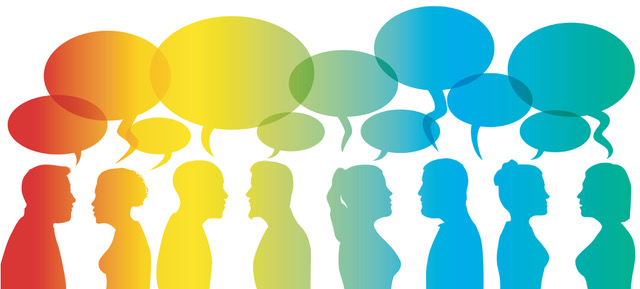By Ute Franzen-Waschke, CreatingWE Institute C-IQ Leadership Team
“Everything happens through Conversations” was the mantra of the late Judith E. Glaser and is a key component of her body of work Conversational Intelligence®, which looks at the neuroscience of conversations and more specifically at the Neurochemistry of Conversations®. At the beginning of June, The CreatingWE Institute’s President, María Escobar-Bordyn, and the Institute’s Senior Consultants, Dr. Debra Pearce-McCall and I had just begun a learning journey in our Foundations of Conversational Intelligence Program with a new cohort of interested professionals and leaders, possessing the desire to learn more about how to shift their conversations in a concrete manner in the moment, one conversation at a time.
In that very first module two great questions emerged. One question was an invitation to reflect together on the distinction between communication and conversations and what the differences between those were, if there were any differences at all; the second question—more of an observation or realization—was that conversations can transform culture.
It goes without saying that we had a wonderful conversation about these two topics—yet, as time is always of the essence in a content-driven session, we had to move on. I am a communication skills expert and a coach who builds culture through conversations, therefore it is no surprise that those conversations resonated with me, and I continued to ponder the questions.
…and this is what I have been thinking about: Communication, especially in organizations, is often seen as a ‘function’, a ‘process’, ‘technicalities’ to inform, share and make available information for the workforce. A conversation can be one way of spreading the news, sharing the information either in person—at a team or department meeting—or through a channel, such as intranet, company internal communication platforms, or social intranet.
For me conversations are at the heart of everything, really everything!
Similar to what Judith said in her quote above, we have conversations at home with family, at work with colleagues, clients, customers, and with ourselves. We have conversations with strangers in shops, in streets, and ‘communicate’ with them to express our needs, wishes, or to complain, share information and observations, and so much more.
Conversations can be easy and light, no-strings attached; and they can be serious, binding, challenging and difficult, even unpleasant. They often happen between two individuals, with more than one other person, especially when it’s the entire team at work, or the entire organization in a larger work meeting. But let’s not forget—at times conversations also just happen between “me, myself and I”!
In organizations there are entire departments in charge of “communication”. For me, this is where the distinction is between conversations and communication. Conversations happen on a personal level, often small scale. Communication, when seen as described above, are functions, departments, and processes that happen on a larger, not necessarily a person-to-person, scale. And a conversation can be one means for us to communicate.
At the organizational level, often what is communicated is not even coming from those that are communicating the message. The content can come from various sources, such as leaders communicating a change initiative, or departments communicating news to their workforce.
How much attention is actually paid to how communication happens at such a large scale? How much thought is put into ways to adapt language to the recipients, including the level of formality or the communication style—even whether the communication channels to use best suit those at the receiving end? Do we best communicate using our internal communication platform, social intranet, a video message, written words by email, or a memo? There are so many options these days.
Giving thought to how we communicate is very important—the words we choose, the channels we use, who can communicate directly with whom.
The ability to converse is an ability that differentiates us from other mammals, as does our capability to converse effectively. Most of us have the ability to converse with words—sometimes even in different languages—but the ability to do just that in an effective manner is something that needs practice, willingness, and intention. Being intentional about how we converse, what impact we have on our conversation partners, and how effective we are in bringing across what we intend to say depends on our openness and willingness to make the effort. Even something as simple and seemingly trivial as “Let’s have a conversation” may not be as simple and trivial after all, and could be challenging in organizational settings as well as personal contexts. But it can shape and transform the culture of an organization.
What I learned from Judith and her body of work about conversations and communication can be summarized as follows:
Start with yourself by creating awareness
Whether it’s me (small scale) or, for example, the Communication Department (large scale)—what are we trying to communicate? Depending on who we are communicating with, what is our intention, and how can we best do it? Are we providing information, sharing data, imparting knowledge, engaging the workforce, starting a change initiative, finding out what’s on people’s minds, or taking the temperature and the pulse of the workforce?
And how do we—as individuals, or as representatives of the Communication Department—feel about the content of the message we are communicating? Sometimes we hold strong personal emotions, sometimes it’s just another piece of news to be shared. When we are personally touched or affected by the topic, we very likely have side conversations with other colleagues that we trust and whose opinions we value about the topic, moving it from the large scale back to the small scale again.
Where am I personally on the topic or in this situation? Am I resisting, skeptical, or on the fence—‘wait and see,’ as Judith termed it on her Conversational Dashboard? Or am I ready to experiment and co-create with my conversation partner or the entire organization? How am I personally showing up for a conversation?
Pausing, noticing, and learning to regulate our own neurochemical reactions have a huge impact on how the conversation evolves, and also how communication develops in a larger setting.
Hone your ability to co-regulate
When I pause to notice what is going on for me before I engage in communication on a larger, for example organizational, scale (is it a topic of concern or joy)—or in a conversation, on a smaller scale, with my peers and colleagues (what is my intention, how do I feel about this conversation and my conversation partner)—it will help me not only regulate my own emotions and neurochemistry. It will also increase my ability to be more agile and effective with my conversation partner, dancing in the moment.
Co-creating and shaping communication and conversations with those around you
The ability we all possess to co-regulate the energy—both in a virtual room as well as in an in-person encounter—with one person or with many, bears the power to change and shift conversations in the moment. That might sound a bit ‘woo-woo’, but it is not. This theory stands on a solid scientific foundation.
And it might also sound as if this is something only experts can do. Yes, that might be right, and… YOU can become such an expert. It does take practice—and sometimes, courage—and it does take a willingness to make a difference. However, if you use the above strategies as an initial checklist and begin with “Creating Self Awareness”, you may notice how your conversations start to shift. Not always, and not in every situation, but more often—the more often you try. Practice creates a habit.
Start small and see what happens. If you see a shift in the way your own conversations go, you might soon see others shifting how they are conversing—that could be the beginning of transforming your communication culture at home, at work, in your communities. It happens one conversation at a time because “Everything happens through Conversations.”
For more information on the Foundations of Conversational Intelligence Program visit https://www.we-iq.com/.








